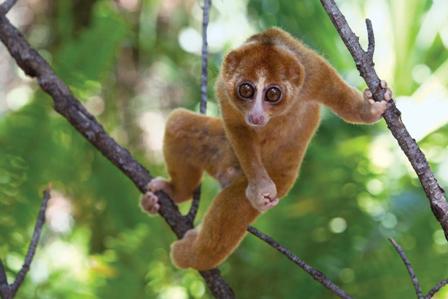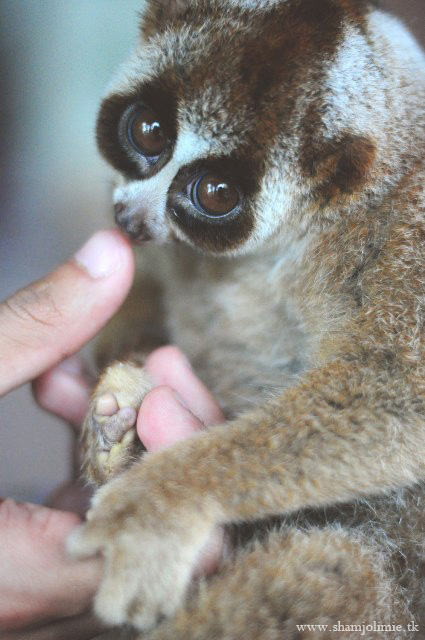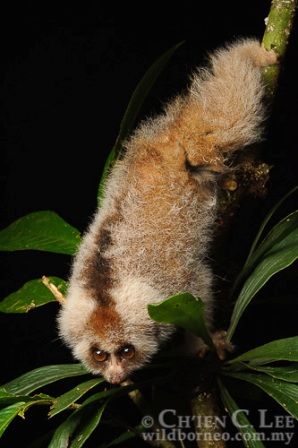
Interactions
A slow loris has many interactions both with other slow lorises, its predators, and also humans.
 Other slow lorises:
Other slow lorises:
Slow lorises have been found to be solitary creatures. They mainly
live on their own, with their young, and can sometimes be found in
couples. Although they don’t live directly in contact with others of
their kind, they live in close vicinities of other slow lorises.
They communicate with others through olfactory communication in
scent marking and with whistling noises.
Slow lorises mark their territory using urine and their brachial glands (see Venom). A usually quiet slow loris will also call to others in signs of danger, mating, or communication from baby to mother. When a slow loris is in danger, it will hiss and make low buzzing noises which signals the problem causer to should back off and warns other slow lorises that there is something wrong. Slow lorises will also call out to each other with low-pitched, non-warning calls. When a signal is high pitched (or a rising note) the call is most likely a female calling for a mate. Babies can get the attention of their mothers through ultrasound.
Predators:
Nycticebus coucang has many predators
including the Indian krait, Ring-tailed civet, the fishing cat,
pythons, hawks,
eagles, and even
orangutans!
Slow lorises do not show any response to owls or civets. The slow
loris has many escape methods from its predators including falling
out of the tree it is in (since it is fully arboreal), biting which
is painful and venomous, or rolling up into a ball with its arms
over the head, which can transport Venom
onto its fur further protecting itself. Also, the slow loris has developed
a dance that mimics a cobra: it will stand with its hands above its
head and sway the way that an attacking cobra would. (See
Adaptations)
Not only does the slow loris get preyed on by bigger organisms, it is also attacked by parasites. Nematodes, tapeworms, and flukes are common problems of the slow loris. These can cause problems such as malnutrition, anemia, diarrhea, and eventually death.
The slow loris also deals with disease like any other animal. Tuberculosis affects most of the primates, including the slow loris; it causes problems ranging between weight loss and death. Other problems the slow loris faces is Salmonella and Dysbacteriosis (unusual fungal and bacteria growth in the digestive tract).
A slow loris is also predator itself. To see what it preys on, see Nutrition.

Humans:
Currently, Nycticebus coucang is listed
by the International Union for Conservation of Nature (IUCN) as
vulnerable. Humans are taking away their home by cutting down forest
areas in which they inhabit (see Habitat).
The loris was rarely seen, but lately has been spotted in suburban
gardens due to lack of food and resources in the forest. In
countries where they reside, there has been mass collection and
illegal resale as the demand for exotic pets increases; however, it
has recently been made illegal in the United States to be in
possession of a slow loris. Another reason for their extreme decline
is because Indonesia hunts the slow loris for medicines and the United States is currently using
Nycticebus species for biomedical research.
To see fun facts about a slow loris, see Facts next!
To see interactions other animals have, go to MultipleOrganisms.net!
Back to Homepage
